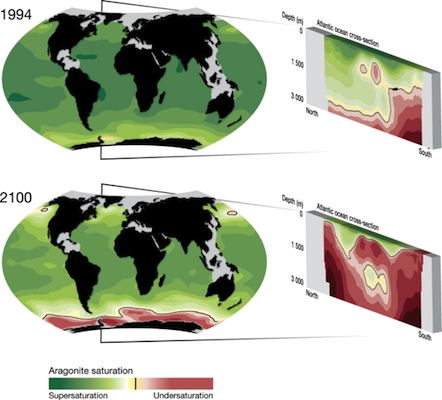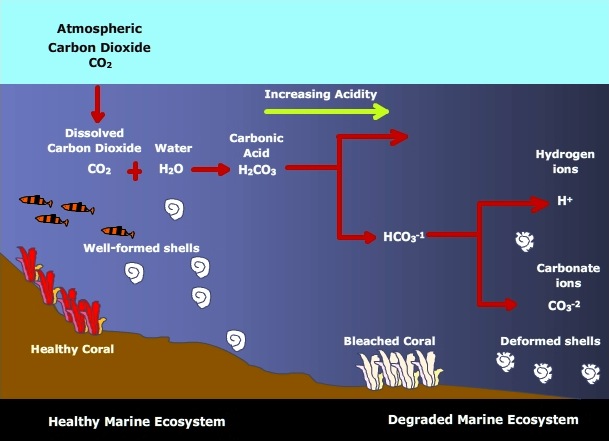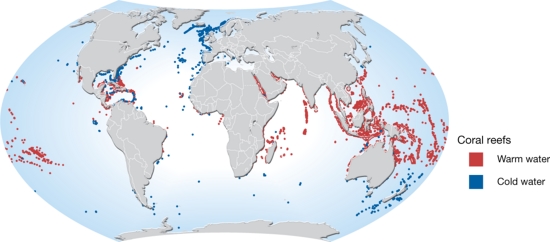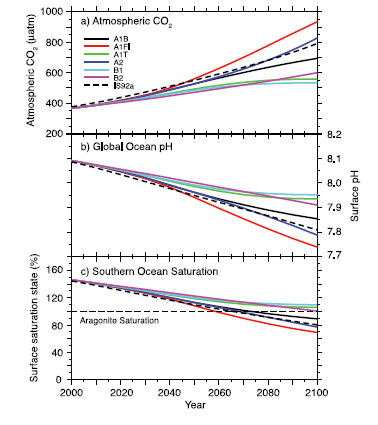Digging Deeper: Ocean Acidification
Oceans play an important role in the natural cycling of carbon dioxide through the Earth System (See: The Carbon Cycle). But the chemistry of the Earth's oceans is changing as a result of the absorption of anthropogenic carbon dioxide emissions. The ocean's absorb about 25% of the carbon dioxide released from human activities each year. The result is a decrease in pH and acidification of ocean water leading to severe consequences for ocean ecosystems.

Figure 2-A Ocean Acidification Courtesy UNEP.
(Cartographer Hugo Ahlenius, UNEP/GRID-Arendal. Sources: Donner, S.D., Skirving, W.J., Little, C.M., Hoegh-Guldberg, O., Oppenheimer, M. 2005. Global assessment of coral bleaching and required rates of adaptation under climate change. Global Change Biology vol, 11, 2251-2265. Orr, James C. 2005. Anthropogenic ocean acidification over the twenty-first century and its impact on calcifying organisms. Nature, vol 437, 681-686.)
How ocean acidification happens
When carbon dioxide (CO2) combines with ocean (H2O) it forms H2CO3, carbonic acid. Most of this acid dissociates into hydrogen ions (H+) and bicarbonate ions (HCO3-1). The increase in H+ ions reduces pH and raising the acidity of ocean water. Since the dawn of the industrial revolution, which was fueled by fossil fuel burning, the pH of Earth's oceans has decreased from 8.2 to 8.1. This doesn't sound like much, but realize that pH is measured on a logarithmic scale. The .1 change represents a 30% increase in acidity. This increase is 100 times faster than any change in acidity for at least the last 20 million years. Under current emission rates, pH will fall by 0.4 between now and 2100, a 3-fold increase in acidity.

Figure 2-B Ocean acidification process
Impacts of ocean acidification
The impact of acid acidification is wide ranging and potentially disastrous for the earth system. Ocean acidification causes or is linked to various impacts on the ocean and its ecosystems. Some of these are:
- Decreasing uptake of atmospheric carbon dioxide as saturation level is approached. Like other elements dissolved in a solution, water has a saturation point beyond which its "sink function" ceases to be effective at absorbing carbon dioxide. As a result, more CO2 is left in the atmosphere to fuel global warming.
- Damage to coral reef ecosystems. Coral reefs are found in two types of ocean habitat, warm water and cold water. Warm water coral reef are typically found at shallow depths and in tropical waters. Cold-water corals are found at much deeper depths and in subtropical to high latitude oceans. Ocean acidification has been shown to hinder the calcification of deep-sea, or cold-water, corals. It is estimated that by 2100, 70% of cold-water corals will be exposed to acidified ocean water. Though excessively warm water is often the cause, acidified ocean water has been linked to coral bleaching. The whitening caused by bleaching occurs when corals lose microscopic algae within their tissues that give corals their wonderful colors.

Figure 2-C Distribution of Coral Reefs
(Courtesy: UNEP Cartographer:Hugo Ahlenius, UNEP/GRID-Arendal. Sources: UNEP World Conservation Monitoring Centre. 2005. Global Cold-Water Coral Distribution (points). Cambridge, UK: UNEP-WCMC UNEP World Conservation Monitoring Centre. 2005. coral1km_v7_2003. Cambridge, UK: UNEP-WCMC)
- Slower growth rates for marine organisms with calcareous skeletons. As carbonic acid forms from the uptake of atmospheric CO2, the hydrogen ion concentration increases limiting access to carbonate ions needed to form shells.
 Figure 2-D Krill and phytoplankton, the foundation of the marine food web. (Source: NOAA)
Figure 2-D Krill and phytoplankton, the foundation of the marine food web. (Source: NOAA)
- Disruption of marine food webs. Impacts on phytoplankton and other sensitive species may disrupt marine food webs and in turn affect fisheries. Phytoplankton are organisms that float on or near the surface of water. Most are single-celled, like diatoms and dinoflagellates,and in the ocean serve as the foundation of the marine food web. Phytoplankton are the primary producers of the ocean, accounting for 95% of the ocean's primary productivity. They serve as food for zooplankton that include copepods, some species of shrimp, and larval forms of jellyfish, barnacles, mollusks, and fish. Small predators like shrimp, krill, sardines, etc feed on the zooplankton, and are in turn eaten by large predators which include birds, large fish, and marine mammals. Loss of the species at the foundation reverberates through the entire food web. Soon, fisheries important to many national economies founder resulting in a degraded marine ecosystem.
Future ocean acidification
Ocean acidification is projected to increase this century as atmospheric carbon dioxide continues to increase. The amount of acidification depends largely on future emissions as shown by the Intergovernmental Panel on Climate Change projections for various emission scenarios. The worse case scenario for ocean acidification is one in which the world continues to use carbon-based energy resources to fuel its economic, industrial, and transportation needs.
Figure 2-E Future CO2, pH and saturation state. (Source EPA)
Audio Program: Acid in the Oceans: A Growing Threat to Sea Life
Courtesy NPR - All Things Considered
